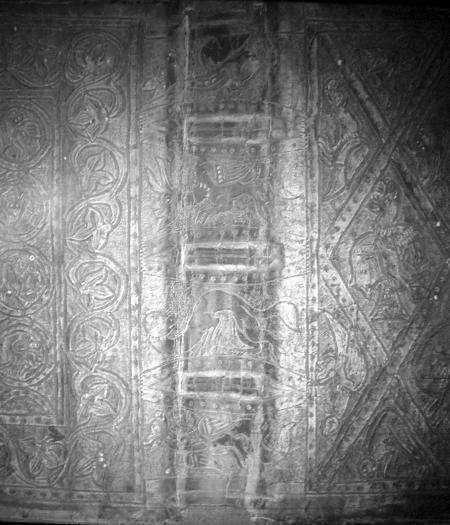Obj. ID: 26154
Hebrew Illuminated Manuscripts Vienna Liturgical Pentateuch, Germany, 14th century

This liturgical manuscript of the 14th century copied in Ashkenaz by a single scribe.
It is highly important for its original binding
sub-set tree:
: Parchment, 264 leaves
Measurements
|
Full page: 214 x305 mm
|
|
Text space: (195-200) x (135-140) mm |
Scribes
The text is written by a single scribe.
Columns
The text is written in one column, except for Shirath Heezinu which is written in two columns (fols. 192v-194).
Script
The text is written in square Ashkenazi script in black ink.
Number of lines
Mostly the text is written in 24 lines per page. Sometimes, there are 22-23 lines.
The scribe finishing the manuscript disposed the text in a way allowing for filling an empty space on the leaf. The same system occurs at the ends of different section. Sometimes, almost all letters of last line are widened for filling the line (e.g. fol. 51).
Ruling
The ruling is done by plummet.
25 horizontal lines + 3 lines at the top and 3 lines at the bottom for massorah magna (never written).
2+2 or 3+2 vertical lines.
Pricking
All four margins are pricked.
Quires
35 quires of 8 leaves each, except for I (8-1) (the first leaf is numbered by Roman "I" and the second one is missing), XXXI (4), XXXIV (1+1) (two single leaves stuck together), XXXV (2+1) (fol. 263 is the last text leaf stuck to fol. 262. Fol. 263v is blank).
It is difficult to discern between hair and flesh sides.
Catchwords
There are irregular catchwords written in the lower left-hand corner on the final verso of some quires. They are horizontal and decorated with dots. Two catchwords are vertical (fols. 206v and 214v).
Hebrew numeration
None
Blank leaves
Fols. 195v and 263v are blank.
The late Gothic leather binding is shaped like a box. It is probably the original binding of the manuscript.
Brown leather partly sewed at the edging, upon upper and lower wooden boards. Holes of center and corners studs in upper and lower covers are noticeable, as well as holes for two clasps in lower cover. Today a center hook on the edge of lower cover hooks onto a ring in the edge of upper cover.
Small stamp of a star was used for the frame. Traces of five large studs and two long clasps are found; from them the middle one is modern.
On the front cover, a rectangular panel bears eight inhabited medallions arranged in pairs and a pair of empty half medallions in the lower row. Within the medallions, there are depictions of animals (birds, monkeys, dragons). The panel is surrounded by a frame filled with a scroll of trefoil leaves.
The back is divided into four rhomboids and triangles by diagonal strips. Within each rhomboid and triangle, there are depictions of animals in various postures (dragons, monkeys and birds, all mostly hybrids).
The spine of the cover is divided by three double cords into four sections head and tail rope bands. Four dragons are depicted within each section.
- Large initial words (5 lines) open the book of Genesis (fol. 1). Other beginnings of the Pentateuch books do not have any initial words. They are separated one from the other by four empty rows. Smaller initial words (2-3 lines) open the pericopes of the Book of Genesis, starting with pericope ויראה (fol. 14v) and the opening words of Haftarot (fols. 203-248v), Song of Songs (fol. 248v), Ruth (fol. 250v), Lamentation (for each chapter) (fols. 253v-256v), Ecclesiastes (fol. 253v), and the last two Haftarot (fol. 262-262v).
- Some letters in the initial words are embellished with decorative elements. For example, the ascenders of lamed is shaped like fleur-des-lys (e.g. fols. 225v, 238v).
- Shaped text on the last leaf of the manuscript (fol. 263) is disposed as two triangles turned to each other with their apexes. The last word is even written vertically. In other cases the text is disposed geometrically, as a triangle plus one line at the end of Ruth (fol. 253).





